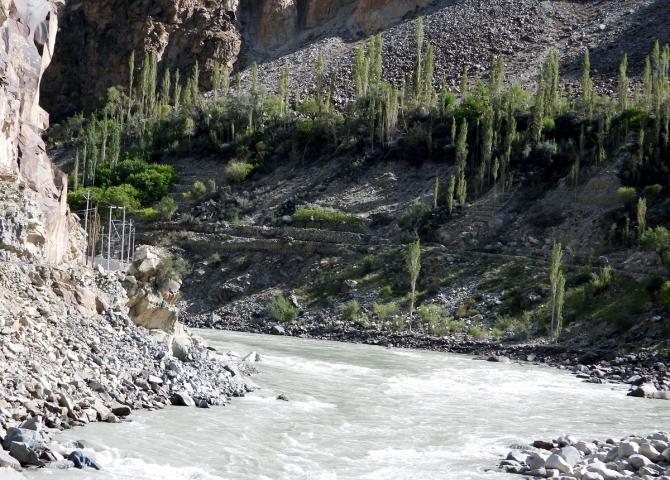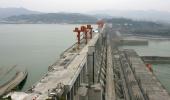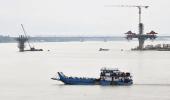'China has thus far been cautious, emphasising its focus on development rather than weaponising water resources.'

With the Indus Waters Treaty in abeyance, Uttam Kumar Sinha, Senior Fellow, Manohar Parrikar Institute for Defence Studies and Analtyes, New Delhi and the author of the book Indus Basin Uninterrupted, widens the lens to China and the Brahmaputra/Tsangpo.
In the concluding part of the interview with Rediff's Prasanna D Zore, Mr Sinha points out no binding treaty governs those flows -- only limited MoUs and a yearly data-share that Beijing controls.
China could, in theory, throttle downstream rivers, but has so far opted for cautious information leverage over outright diversion.
India, by contrast, needs more storage in Arunachal Pradesh and stronger legal mechanisms -- moving from ad hoc MoUs to a permanent Himalayan Rivers Commission -- to safeguard its northeast and deter upstream coercion.
- PART 1: 'Indus Water Treaty On Deliberate Pause'
- PART 2: 'Weaponising Water Poses Serious Risks For India'
Can China retaliate against India by blocking or diverting the Brahmaputra (Tsangpo) as India is doing with the Indus? How vulnerable is India to such a move?
China could theoretically retaliate against India by manipulating the Brahmaputra, but the feasibility and consequences of such an action are complex.
China has thus far been cautious, emphasising its focus on development rather than weaponising water resources.
International pressure and diplomatic consequences could dissuade China from taking such drastic steps, as it would risk destabilising relations not only with India but with Bangladesh as well.
Are there any existing water treaties between India and China like the IWT, or are river waters shared purely on the basis of mutual understanding?
The Yarlung Zangbu-Brahmaputra despite its massive basin expanse and as the fifth largest river in terms of volume remains ungoverned with no permanent agreement or treaty.
There, however, exists a non-permanent mechanism for hydrological data sharing that is contractual, limited in scope and non-binding.
In 2002, India had entered into a MoU for a period of five years with China on the provision of hydrological information on the Brahmaputra in flood season.
The information related to water level, discharge, and rainfall at three specified stations, Nugesha, Yangcun, and Nuxia, from June 1 to October 15 every year, is utilised in the formulation of flood forecasts by the Central Water Commission.
Another MoU was signed in April 2005 for the supply of hydrological information in respect of the Sutlej (Langquin Zangbu) in flood season for a period of five years and was renewed in 2010 and again in 2016.
By reviewing and renewing the MoUs on the Brahmaputra and the Sutlej, China dictates the proceedings as an upper riparian.
Further to the existing mechanisms, in November 2006, it was agreed to set up an Expert-Level Mechanism (ELM) to discuss wider cooperation beyond flood season hydrological data to emergency management.
Subsequently, a Joint Expert Level Mechanism was constituted at the joint secretary level. The JELM meets once a year alternately in Beijing and New Delhi and essentially focuses on the exchange of hydrological information and for the smooth transmission of flood season hydrological data.
Though again limited in scope, it can form the base on which future water cooperation can be developed. This, however, remains a long shot given the current political climate.
Given China's ongoing hydro projects in Tibet, how should India balance its water strategy against both Pakistan and China simultaneously?
Keeping the Indus Waters Treaty in abeyance is a smart strategic move. It signals India's intent.
Ultimately, it could push Islamabad to renegotiate the Indus Waters Treaty on more contemporary terms -- factoring in advances in hydrological science, modern engineering, and removing outdated restrictions that have long hindered India's development plans on the western rivers.
With China, India needs to have more water development footprints in Arunachal to enhance economic growth in the region particularly building more water storages to mitigate dry season flow and thereby exert down riparian prior appropriation rights.
It must not be forgotten that China's claim to the Arunachal territory is also a claim to the vast amount of water flowing in the area.
Greater economic integration in the border region is an effective way to neutralise China's claim.
Of course the hydro projects in Arunachal, apart from being scientifically sound and technologically robust, need to be framed in a cooperative and consultative manner with wider stakeholder and inter-provincial participation in the north-east particularly with Assam which is downstream to Arunachal.
It will be counter-productive for India to create upstream and downstream acrimony within its own territory.









